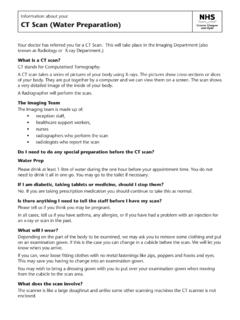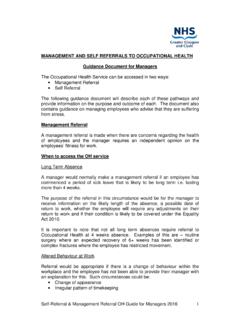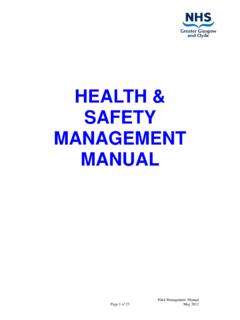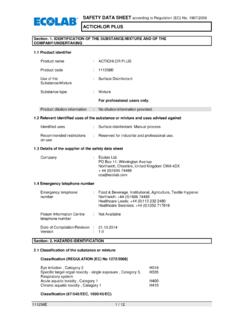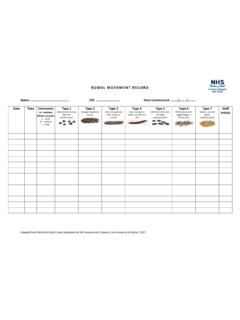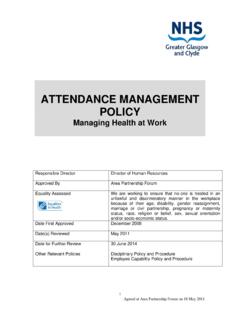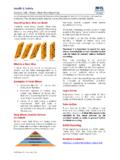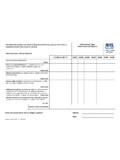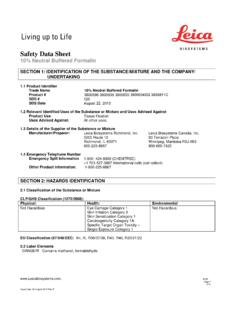Transcription of CT Colonography (Gastrografin Preparation)
1 Information about your CT Colonography ( gastrografin preparation ). What is CT Colonography ? CT Colonography is a test which uses a CT scanner to produce images of the large bowel (colon and rectum). During the test, we inflate the bowel with gas through a thin flexible tube we place in your back passage. We take scans with you lying on your back, and then on your front. Doctors can then look at the scans for polyps and signs of cancer. What preparation is required before the test? To give us a clear view, your bowel must be clear of stool before the test. We call this bowel preparation and we will give you gastrografin to take before the test. gastrografin is a mild laxative which will remove most stool, but also helps us distinguish stool from polyps. You will need to follow strict instructions regarding the gastrografin , and your diet, or the test may fail, and may need repeating. These instructions are at the end of this booklet.
2 Where will the test take place? In the CT scanner room in the Radiology or Imaging Department. What happens during the test? The radiographer will explain the test and answer any questions you have. Please let them know if you have had any problems with your bowel preparation . Please also tell them if you have any of the following: diabetes, asthma, kidney disease, glaucoma, prostatism, angina or other heart problems, or any allergies, especially to x-ray contrast injections. The test only takes around 20 -30 minutes, but you may be in the department for 1 to 2 hours. We will place a needle into a vein in your arm. We will ask you to lie on the scanner table on your left side, and the radiographer will place a short flexible tube into your back passage. We may give you a muscle relaxant to avoid bowel spasm. We will gently introduce gas (Carbon Dioxide) into your bowel through the tube, at a controlled rate by a machine. You may feel some discomfort and bloating in your tummy.
3 Once the radiographer is satisfied with the amount of gas in your large bowel, they will give you an injection of iodine based contrast through the needle in your arm. This may give you a warm flushing sensation but this only lasts a few seconds. You will lie on your back for the first scan, and we will then ask to turn on to your front for a second scan. Each scan only lasts around 20 seconds. We will then remove the tube, but we will ask you to stay in the department for 15-20. minutes before going home. You may eat and drink normally. When will I know the result? The results will not usually be available at the time of the test. If the test was arranged from the out-patient clinic, we will send the results to the clinic. If you do not yet have a return appointment, and after three weeks you have not heard anything, contact the outpatient clinic or your GP for advice. Are there any risks? CT Colonography is regarded as a very safe test.
4 Very rarely, problems can occur, and if they do, they are similar to those which could happen with other methods of examining the bowel. These include the following: Abdominal discomfort Faint-like reactions Reaction to the injected contrast Damage to the bowel wall (a small tear in the lining, very rare, fewer than 1 in 3000 tests, and usually not serious). Blurry eyes (from the muscle relaxant). This test uses X-rays, but these are kept to the minimum There is a slight risk from the muscle relaxant (Buscopan) to patients with closed angle glaucoma, heart problems or prostate problems. Your doctor has recommended this test because they feel that the benefits are greater than the risk of not having the test. Even so, we cannot guarantee that this test will detect all abnormalities in the bowel. Precautions You should continue to take any medication as normal. If you have a colostomy, or could be pregnant, please call us for advice on the number on your appointment letter.
5 If you are diabetic, we can arrange an early morning appointment. You may need to discuss your diabetes management during bowel preparation with your GP, hospital doctor or your diabetic team. Please do not start your bowel preparation before you have done this. Important instructions about your Bowel preparation To give us a clear view of the bowel lining, your bowel has to be cleared of stool before the test. You must follow the following instructions carefully, or the test may need repeating. You can expect to have frequent loose motions (like diarrhoea) after taking the gastrografin so stay close to a toilet. Preparing the gastrografin We have given you three bottles of 20ml gastrografin . You should dilute the contents of a bottle in a glass of water or diluting juice. Please see below for when you should take the gastrografin . Two days before your scan Eat a low fibre diet see the list of foods later in this booklet. Take the first bottle of gastrografin at breakfast, diluted in water.
6 One day before your scan Breakfast: Eat a low fat and fibre diet, fruit juice, tea, coffee, white bread or toast but no milk in any of your drinks. Take the second bottle of gastrografin , diluted in water. Drink plenty of fluid; water juice, tea, coffee, but no milk in any of your drinks. Lunch: Low fat steamed or grilled fish, chicken or lean meat, peeled potatoes, white bread, but no vegetables, milk or butter see the list of foods later in this booklet. Drink plenty of fluid; water,2 juice, tea, coffee, but no milk in any of your drinks. Evening Meal: Clear soup (no bits) or jelly. No solid food. Take the remaining bottle of gastrografin , diluted in water. Drink as much fluid as possible water, juice, tea, coffee, but no milk in any of your drinks. Do not eat anything else. On the day of your scan Breakfast: A slice of dry toast. Drink as much fluid as you like, water juice, tea, coffee, but no milk in any of your drinks.
7 Do not eat anything else until after your scan. Foods you can eat Tender lean meat, poultry, ham, liver, kidney, texturised vegetable protein Fruit flavoured or set yoghurt Peeled potatoes, boiled, mashed, roasted Carrots, turnips, swede, cauliflower (no stalks). Clear or strained soup Soft tinned fruit in juice (no pips). White bread, flour, rice or pasta Water biscuits, cream crackers, rich tea Plain scone (no fruit). Honey, syrup, ice cream Tea, coffee, sugar, sweeteners, (you can't have milk with your tea or coffee). Tomato juice, clear fruit juice, diluting juice Water and fizzy drinks Foods to avoid Tough meat, beefburgers, sausages Sausage rolls, pies, pasties, pastries Milk, butter, cheese, margarine, fats and oils Whole fruit or muesli yoghurts Jacket potatoes must be peeled All other fruit, vegetables and salad Thick soup, baked beans Wholemeal bread or flour, whole wheat pasta, brown rice High fibre crispbread, digestives, hobnobs Cakes with fruit, nuts, coconut Nuts and dried fruit Jam or marmalade with peel or pips High fibre cereals, porridge, muesli, bran Contact Centre Telephone Number 0141 347 8379.
8 Review Date: July 2018 MI 265506b
